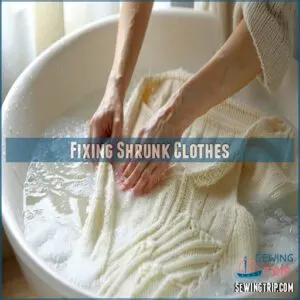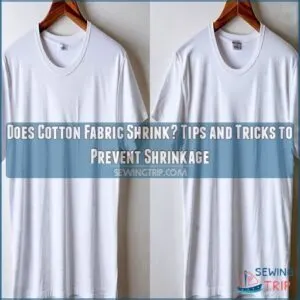This site is supported by our readers. We may earn a commission, at no cost to you, if you purchase through links.

Stick to the gentle cycle and use a mild detergent to avoid stressing delicate fabrics.
Skip the dryer heat if you can; air drying works wonders.
If you must use a dryer, go for the lowest heat and take clothes out while they’re slightly damp to reshape them.
Always read the care labels; they’re like secret cheat codes for keeping clothes in top shape.
Choosing fabrics like polyester blends also helps minimize shrinkage.
With these steps, your handmade treasures will last beautifully over time!
Table Of Contents
Key Takeaways
- Wash your clothes in cold water with a gentle cycle and mild detergent to protect delicate fibers and prevent shrinkage.
- Skip the dryer or use the lowest heat setting, and air-dry clothes whenever possible for best results.
- Read care labels carefully—they guide you on water temperature, washing methods, and drying techniques.
- Choose synthetic or blended fabrics for better shrink resistance, and store items in a cool, dry place to maintain their shape.
Choosing Right Fabric
You’ll save yourself from the heartbreak of shrunken clothes by picking the right fabric before you start sewing your handmade garments.
While natural fibers like cotton and wool tend to shrink more easily, synthetic materials like polyester and nylon, or even better – fabric blends, will help your clothes keep their shape after washing, which prevents the issue of heartbreak.
Natural Fibers Prone to Shrinking
Your handmade clothes made from natural fibers require special attention to prevent unwanted shrinkage.
Cotton, wool, linen, silk, and cashmere are particularly vulnerable to losing their shape when exposed to heat and moisture.
These natural textiles react strongly to temperature changes, making them tricky to care for.
To maintain your precious handmade garments, you’ll need to understand how these delicate fibers behave and adjust your washing routine accordingly.
Understanding fabric shrinkage rates is essential for the longevity of your handmade clothes.
Synthetic Fibers Resistant to Shrinking
How can you make sure your handmade clothes stay perfectly sized? Turn to synthetic fabrics, your best allies against shrinkage.
These modern materials resist changes in size and shape, making them ideal for lasting garments. Natural fibers, however, are more prone to shrinkage.
Here’s why synthetic fabrics excel at preventing shrinkage:
- Polyester maintains its shape even after multiple washes
- Nylon offers exceptional durability against heat exposure
- Spandex retains elasticity wash after wash
- Acetate keeps its form in various conditions
- Polypropylene resists moisture-related size changes
Benefits of Blended Fabrics
While synthetic fabrics shine in shrink resistance, blended fabrics offer you the best of both worlds.
By mixing natural and synthetic fibers, you’ll get clothes that keep their shape while staying comfortable.
Here’s what fabric blends can do for your handmade wardrobe:
| Blend Type | Benefits | Key Features |
|---|---|---|
| Cotton-Polyester | Better shape retention | Enhanced tensile strength |
| Polyester-Viscose | Improved durability | Soft, natural feel |
| Wool-Nylon | Less shrinkage | Warmth without bulk |
Understanding the fabric selection criteria is essential when creating handmade clothes.
These textile combinations give your garments superior shrink resistance while maintaining the comfort you love, and provide a natural feel with enhanced tensile strength and improved durability.
Washing Practices Matter
You’ll find that proper washing techniques can make all the difference between keeping your handmade clothes looking perfect or turning them into doll-sized disasters.
By mastering a few simple washing practices, you can protect your cherished handmade garments from shrinking and maintain their original size and shape for years to come.
Checking Care Labels
Now that you’ve picked your fabrics, let’s talk about those tiny tags that pack a big punch.
Your handmade clothing care starts with understanding care label instructions. Think of care labels as your garment’s secret recipe for success.
Those fabric codes and washing symbols might look like hieroglyphics, but they’re your best defense against shrinkage. Take a moment to decode garment tags before washing handmade garments – your clothes will thank you, and it’s the key to success.
Washing in Cool Water
Now that you’ve read those care labels, let’s talk about water temperature – your secret weapon against shrinkage.
Cool water (85°F/30°C) is your best friend when washing handmade garments. Unlike hot water that contracts fibers, cold water helps maintain your clothes’ shape and color.
You’ll notice the difference in fabric relaxation right away. Plus, you’ll save energy while preventing those heart-sinking moments when your favorite piece comes out smaller than before, which can be a real heart-sinking experience.
Gentle Cycle for Delicate Fabrics
Working with delicate fabrics requires a gentle touch, especially for your handmade clothes.
When using the gentle wash cycle, you’ll protect your garments from unnecessary stress and prevent shrinking.
Here are three key steps for success:
- Select cold water and the delicate setting for minimal agitation
- Use a soft detergent specifically designed for delicate fabrics
- Choose the shortest spin cycle to reduce fabric strain
Remember, treating your handmade pieces with care guarantees they’ll last longer.
Preventing Shrinkage Tips
You’ll find that preventing your handmade clothes from shrinking isn’t as tricky as you might think, especially when you know the right techniques for heat control and gentle washing.
By following these practical tips for proper temperature settings and careful agitation, you’ll keep your cherished handmade garments looking just as perfect as the day you made them.
Avoiding Excessive Heat
Now that you’ve mastered reading care labels, let’s tackle heat – your clothes’ sneaky enemy.
High temperatures can turn your favorite handmade pieces into doll-sized disasters.
Here’s your heat-smart guide:
| Heat Source | Safe Approach | Warning Signs | Prevention Tips |
|---|---|---|---|
| Dryer | Use low heat | Wrinkled edges | Air dry when possible |
| Iron | Test on hem | Shine marks | Use pressing cloth |
| Washer | Choose cold | Steam rising | Skip hot cycles |
| Sunlight | Dry in shade | Fabric fading | Hang indoors |
Remember, lower temperatures mean longer-lasting clothes. Your handmade garments will thank you!
Minimizing Agitation and Spin
Like a gentle breeze caressing delicate petals, minimizing agitation and spin speed protects your handmade clothes from shrinking.
You’ll want to use delicate wash cycles or hand wash clothes to maintain fabric softness. Understanding cotton fabric shrinkage is essential for effective care.
Here’s how to prevent shrinking clothes:
- Use a mesh laundry bag for extra protection
- Select the gentle cycle setting on your washer
- Reduce spin speed to minimum
- Keep water temperature cool
- Control agitation by not overloading
The key to successful care is maintaining the right conditions to prevent damage, and delicate wash cycles are crucial for this. By following these steps, you can ensure your handmade clothes remain in good condition, and understanding the importance of cotton fabric shrinkage will help you make informed decisions about their care. Prevent shrinking clothes by being mindful of these factors.
Using Gentle Detergents
Now that you’ve adjusted your machine settings, let’s talk about what goes into it.
Your choice of detergent can make or break your handmade clothes. Stick to mild soaps specifically designed for delicate fabrics – they’re gentler on fibers and help prevent shrinkage.
Skip harsh fabric softeners that can weaken clothing fibers. For extra protection, try eco-friendly detergents or natural soap alternatives like wool wash when you hand wash clothes.
When selecting a detergent, consider using a mild laundry option to preserve the quality of your handmade items, and remember that the right choice can help prevent shrinkage and ensure the longevity of your handmade clothes.
Drying Clothes Correctly
You’ll save your handmade clothes from shrinking by picking the right drying method, whether it’s gentle machine drying or hanging them up to air dry.
When you’re using the dryer, keep the heat setting low and don’t forget to take your clothes out right away to prevent those dreaded shrinking disasters.
Lower Dryer Heat Settings
Now that you’ve mastered smart washing habits, let’s protect your handmade treasures in the dryer.
Setting your dryer’s temperature control to low or medium heat is your best defense against shrinkage.
Here’s what happens at different heat settings:
- High heat (175°F+): Causes severe shrinkage and fabric damage
- Medium heat (135°F): Moderate risk of shrinkage
- Low heat (125°F): Minimal shrinkage risk
- Ultra-low heat (115°F): Best for delicates
- No heat: Safest option but takes longer
Understanding ideal dryer heat settings is essential for fabric care, and you can learn more at dryer heat settings.
You’ll save energy and extend your clothes’ lifespan with lower temperatures, which is key to maintaining your handmade treasures.
Air Drying to Prevent Shrinkage
The gentle art of air drying protects your handmade treasures from unwanted shrinkage.
Set up a sturdy drying rack in a well-ventilated space, away from direct sunlight. Reshape wet clothes while they’re damp to maintain their original form.
Understanding cotton fabric shrinkage is key to prevent damage to your handmade clothes.
| Method | Benefits | Best For | Tips |
|---|---|---|---|
| Flat drying | Prevents stretching | Sweaters, knits | Use clean towel underneath |
| Hanging | Reduces wrinkles | Shirts, pants | Space items apart |
| Drying rack | Saves space | Multiple items | Position in airflow |
| Line drying | Natural freshness | Sturdy fabrics | Avoid direct sun |
The benefits of each drying method are distinct, with flat drying being ideal for sweaters and knits, hanging for shirts and pants, drying rack for multiple items, and line drying for sturdy fabrics seeking natural freshness.
Removing Garments Promptly
Rescue your favorite handmade pieces from the dryer’s time trap.
Quick action prevents wrinkles and preserves your garments’ shape.
Here’s why prompt removal matters:
- Stops clothes shrinking by preventing overdrying and heat damage
- Lets you reshape wet clothes while they’re still slightly damp
- Makes fast drying and quick folding easier
- Helps prevent color fading from excess heat exposure
- Keeps your handmade clothes looking fresh and pristine
Remember, timing is everything when drying handmade clothes.
Your garments will thank you!
Fixing Shrunk Clothes
If you’ve accidentally shrunk your favorite handmade sweater or dress, don’t panic because there’s still hope to rescue it.
You can often restore shrunken clothes to their original size using simple techniques like soaking in lukewarm water with hair conditioner and gently stretching the fabric back into shape, which can help restore the item to its original form with simple techniques.
Soaking in Lukewarm Water
When your favorite handmade clothes have shrunk, lukewarm water becomes your secret weapon for fiber restoration.
You’ll find this gentle soaking method especially effective for natural fibers. The water temperature should be comfortable to touch – around 85°F (30°C).
| Fabric Type | Soaking Time | Special Care |
|---|---|---|
| Cotton/Linen | 30 minutes | Add hair conditioner |
| Wool/Cashmere | 15 minutes | Use baby shampoo |
| Silk/Rayon | 10 minutes | Add white vinegar |
Fill your basin with lukewarm water and a mild solution to prevent color fading while the fibers relax, using a method that is especially effective for natural fibers and requires gentle soaking.
Gently Stretching and Reshaping
Many shrunken garments can bounce back to life through careful manual stretching and reshaping.
When your handmade clothes need fiber recovery, try these fabric relaxation techniques:
- Lay your damp garment flat on a clean towel and gently pull the fabric outward from the center
- Apply even pressure while stretching to maintain the garment’s shape
- Use steam treatment for stubborn areas that resist stretching
- Block knitted items on a foam mat using rust-proof pins
Remember, patience is key – rushing the process can damage delicate fibers, and it’s essential to handle them with care for successful fabric relaxation.
Seeking Professional Dry Cleaning
Sometimes professional dry cleaning becomes your last resort when home remedies aren’t cutting it.
For delicate handmade clothes that have shrunk substantially, a skilled dry cleaner can work wonders with specialized fabric restoration techniques.
They can also offer advice on removing stains from delicate fabrics, and they’ll assess your garment’s unique needs, use professional-grade solvents, and employ expert methods to gradually restore its shape.
Don’t hesitate to ask about their experience with similar garment preservation challenges before trusting them with your treasured pieces, as this will help ensure the best possible outcome for your delicate items.
Proper Storage Methods
Keeping your handmade clothes in good shape starts with proper storage. Store them in a cool, dry place, away from moisture and heat, to prevent shrinking and maintain their quality.
Temperature-Controlled Environments
Keeping handmade clothes in temperature-controlled spaces protects their shape and fabric.
Fluctuations in temperature can stiffen or weaken fibers, undoing all your hard work.
Here’s how:
- Set storage areas to moderate temperature settings to avoid fiber stress.
- Use closets or drawers free from extreme warmth or cold.
- Avoid direct sunlight, as it heats fabric and fades colors.
Gentle care maintains long-lasting, beautiful clothes, and following these steps ensures that you preserve the shape and fabric of your handmade items.
Avoiding High Humidity
Humidity control is key to preserving handmade clothes.
Damp environments weaken fibers, risking shrinkage and mold. Store garments in a dry space with good air circulation.
Use moisture management tools like silica gel or dehumidifiers for added protection. Avoid closets near bathrooms or humid areas.
For extra care, air-dry clothes completely before storage, especially natural fiber items, to prevent damage and maintain shrink prevention efforts.
Using Garment Boxes or Bags
A good storage setup prevents shrinkage and keeps handmade clothes in top shape.
Use garment boxes or bags to shield them from dust, moisture, and sunlight.
For efficient closet organization, follow these storage tips:
- Choose breathable garment bags for airflow.
- Use acid-free tissue in boxed clothing.
- Store off-season items flat.
- Avoid overpacking to prevent fabric stress.
- Label bags for easy garment care.
Hand Washing Delicates
Hand washing delicate clothes gives you more control over water temperature and handling, helping to prevent shrinkage.
By using cold water, gentle techniques, and avoiding harsh detergents, you can keep your handmade items looking their best.
Choosing Cold Water
Cold water washing is your best bet to stop clothes shrinking.
The lower water temperature helps maintain fabric safety, especially for delicate items like wool or silk.
Gentle washing in cold water prevents shrinkage by avoiding fiber contraction, which happens in hot water.
It’s a simple, effective method to avoid clothes shrinkage and preserve garment quality.
For a wool wash, cold water keeps everything soft, intact, and looking its best.
Gentle Hand Washing Techniques
Your handmade clothes deserve a little extra love during hand washing to prevent shrinkage.
Follow these steps carefully:
- Use cool to lukewarm water temperature to protect fibers.
- Select a mild soap designed for delicate fabrics.
- Gently swirl and pat – no scrubbing or wringing!
- Handle fabrics carefully to avoid stretching or distortion.
- Use flat drying methods to maintain shape without pulling or shrinking.
Avoiding Harsh Detergents and Fabric Softeners
Stick with mild detergents when washing handmade clothes to protect delicate fabrics.
Harsh soaps can break down fibers, leading to shrinkage or wear. Skip traditional fabric softeners—use softener alternatives like vinegar or ecofriendly options that preserve fabric integrity.
Gentle wash practices paired with cold water washing are your best bet. An ecofriendly detergent guarantees fabric protection while being kind to the environment.
Keep it simple for longer-lasting, beautiful pieces! Using a gentle detergent is essential for maintaining the quality of handmade clothes, and it’s a key part of gentle wash practices that help preserve fabric integrity with cold water washing.
Frequently Asked Questions (FAQs)
How do you hand wash clothes without shrinking them?
Washing clothes shouldn’t be a disaster movie.
Use lukewarm water, a gentle detergent, and minimal agitation.
Gently press out water—don’t wring or twist.
Lay flat to air dry and avoid heat like it’s the villain.
How to stop clothes from shrinking in the wash?
Always read the care label, wash in cold water on a gentle cycle, and use a mild detergent.
Skip the dryer—air drying is your best bet to maintain size and prevent shrinkage.
How to prevent 100% cotton from shrinking?
Think of cotton like a sponge—it reacts to heat and moisture.
Wash it in cold water, use a gentle cycle, and air-dry flat.
Avoid high heat dryers, as they’ll shrink it noticeably.
Can you reverse fabric shrinkage?
You can often reverse fabric shrinkage by soaking the item in lukewarm water with conditioner, gently stretching it back to size, and air-drying.
For stubborn cases, steaming or professional dry cleaning might help.
How to preserve handmade embroidery from shrinking?
Treat your handmade embroidery like a delicate treasure.
Use cold water, avoid excessive agitation, and air-dry flat to preserve its beauty.
Gentle care makes sure fibers stay intact, protecting your hard work from shrinkage and distortion, which is crucial for maintaining the embroidery’s original beauty.
Can natural dyes affect shrinkage in fabrics?
Natural dyes don’t directly cause shrinkage, but the dyeing process can.
The dyeing process can shrink fabrics, especially natural fibers, due to hot water, agitation, or heat used during dyeing.
Use lukewarm water and gentle methods to reduce risks.
Does the thread type impact overall shrinkage?
Threads can make or break your masterpiece—literally!
The thread type matters because synthetic threads shrink less than natural ones.
For even results, use threads that match the fabric’s shrinkage tendencies, avoiding distortions after washes.
How to safely wash handmade knitted garments?
Wash handmade knitted garments gently in cold water, using mild detergent.
Avoid wringing or stretching.
Lay them flat on a towel to dry, reshaping as needed.
Prevent shrinking by skipping dryers and hot water altogether.
What’s the best way to store handmade clothes?
Store handmade clothes in a cool, dry place away from sunlight and moisture.
Fold them neatly to avoid stretching, and use breathable garment bags or acid-free tissue paper for delicate items.
Avoid hanging knitted garments.
Conclusion
While shrinking handmade clothes is frustrating, preventing it’s simple with the right steps.
Use cold water instead of hot—gentler and safer. Read care labels like instruction manuals, not suggestions.
Skip high dryer heat; air drying is your best friend. For delicate fabrics, choose mild detergents and the gentle cycle.
Synthetic blends? They’re your allies against shrinkage. Follow these habits, and your handmade pieces will stay beautiful, fitting just right after every wash. It’s worth it!
- https://www.whirlpool.com/blog/washers-and-dryers/how-to-prevent-shrinking-clothes.html
- https://www.rinse.com/blog/care/how-to-keep-your-clothes-from-shrinking/
- https://bynext.co/blog/how-avoid-clothes-shrinking/
- https://www.maytag.com/blog/washers-and-dryers/how-to-help-prevent-clothes-shrinking.html
- https://oxxousa.com/shrink-no-more-3-secrets-to-reversing-shrinkage-in-your-clothes/

















